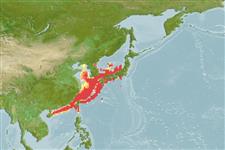分類 / Names
俗名 | 同種異名 | Catalog of Fishes(屬, 種) | ITIS | CoL | WoRMS | Cloffa
Elasmobranchii
板鰓亞綱 (鯊魚與魟魚) (sharks and rays) >
Squatiniformes (Angel sharks)
扁鯊目 (Angel sharks) >
Squatinidae (Angel sharks)
琵琶鮫科 (Angel sharks)
Etymology: Squatina: Latin for skate, which angel sharks superficially resemble, presumably tautonymous with Squalus squatina Linnaeus 1758 (no species mentioned). (See ETYFish); japonica: -ica (L.), belonging to: Japan, referring to Nagasaki, type locality. (See ETYFish).
More on author: Bleeker.
Environment: milieu / climate zone / depth range / distribution range
生態學
海洋 居於水底的. 亞熱帶的; 41°N - 19°N, 111°E - 139°E (Ref. 54906)
Northwest Pacific: Japan, Yellow Sea, Korea, and northern China.
西北太平洋: 日本,黃海,韓國與中國北部。
大小 / 重量 / 年齡
Maturity: Lm ? range ? - ? cm
Max length : 200 cm TL 雄魚/尚未辨別雌雄; (Ref. 247)
背棘 (總數) : 0; 臀棘: 0. Japanese angelshark Squatina japonica has broad pectoral fins with rounded free rear tips, posterior margin nearly straight, inner margin strongly convex; nasal barbels simple and spatulate. Anterior nasal flaps smooth to weakly fringed; dermal folds on sides of head without lobes. Rear tip of inner margin of pelvic fins considerably anterior to origin of first dorsal; very short hypocercal tail. Rows of moderately large spines on midline of back and tail from head to dorsal fins and between fin bases, and on snout and above eyes. Body color blackish brown with small dark and pale spots; no ocelli (eye-like spot) (Ref. 247, 31369, 12951).
日本琵琶鮫 Squatina 日本產植物 寬的胸鰭有圓形的鰭游離後端,後緣幾乎是直的, 內緣強烈中凸; 鼻骨觸鬚單一而竹片狀的。 前鼻瓣平滑的到微弱地邊緣了; 沒有葉的在頭側上的表皮的摺層。 腹鰭的內緣的後頂端非常地位於第一背鰭的起源前; 非常短的 hypocercal 尾部。 在背面與從頭部到背鰭的尾部中線上的列的普通大的棘與在鰭的基底之間, 與在吻與眼睛上方上。 體色暗褐色的有小黑而灰白的斑點; 沒有假眼斑 (眼狀的斑點).(參考文獻 247,31369,12951)
A little-known angelshark, found on or near the bottom (Ref. 247). Lives in sandy ground. A carnivore that eats benthic animals (Ref. 9137). Ovoviviparous (Ref. 50449). Utilized for human consumption and for preparation of shagreen (Ref. 247).
所知極少的琵琶鮫, 發現在底部上面或附近。 (參考文獻 247) 生活在沙的地面。 一個吃底棲的動物的食肉動物.(參考文獻 9137) 卵胎生的.(參考文獻 50449) 供人類食用與對於鯊魚皮的材料.(參考文獻 247)
Life cycle and mating behavior
Maturities | 繁殖 | Spawnings | Egg(s) | Fecundities | 仔魚
Ovoviviparous, embryos feed solely on yolk (Ref. 50449).西北太平洋: 日本,黃海,韓國與中國北部。
Compagno, L.J.V., 1984. FAO Species Catalogue. Vol. 4. Sharks of the world. An annotated and illustrated catalogue of shark species known to date. Part 1 - Hexanchiformes to Lamniformes. FAO Fish. Synop. 125(4/1):1-249. Rome, FAO. (Ref. 247)
IUCN 瀕危狀態 (Ref. 130435)
極危 (CR) (A2d); Date assessed: 29 August 2019
人類使用
漁業: 低經濟
工具
特別的報告
下載 XML
網路資源
Estimates based on models
Preferred temperature (Ref.
123201): 5.7 - 20.7, mean 17.3 °C (based on 123 cells).
Phylogenetic diversity index (Ref.
82804): PD
50 = 0.5000 [Uniqueness, from 0.5 = low to 2.0 = high].
Bayesian length-weight: a=0.00676 (0.00293 - 0.01558), b=3.07 (2.88 - 3.26), in cm total length, based on LWR estimates for this Genus-body shape (Ref.
93245).
營養階層 (Ref.
69278): 3.5 ±0.37 se; based on food items.
回復力 (Ref.
120179): 低的, 最小族群倍增時間4.5 - 14 年 (Fec assumed to be <100).
Fishing Vulnerability (Ref.
59153): Very high vulnerability (90 of 100).
